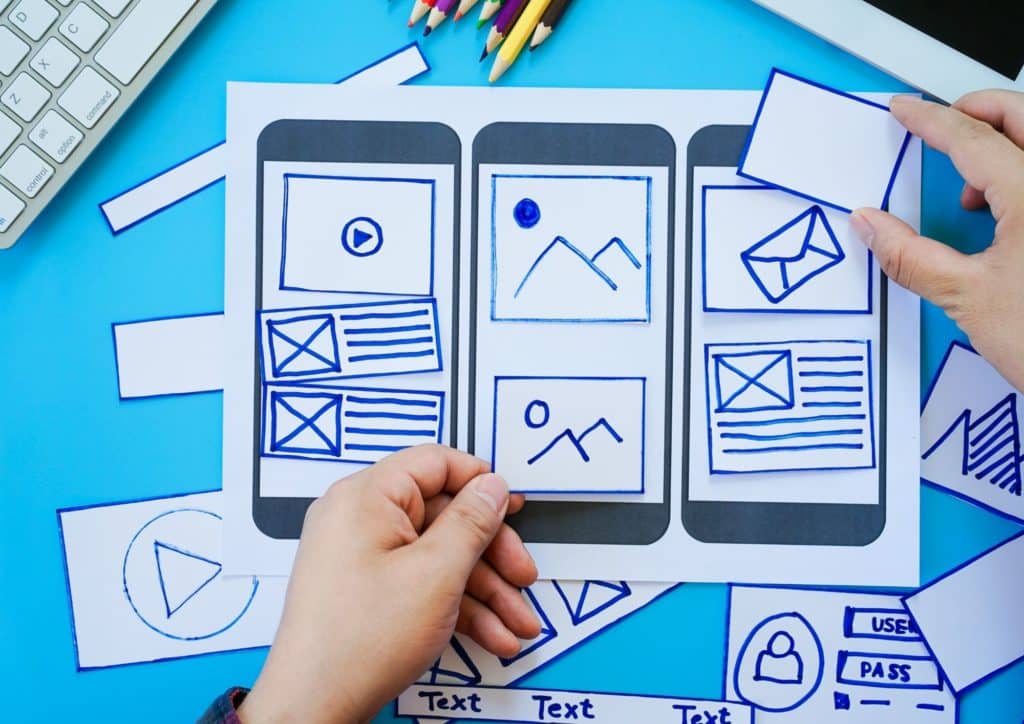UX and UI, so User Experience and User Interface, are an important part of every IT project. Even if they are closely related fields, it is essential to understand that they are not the same.
But what is the User Experience or the User Interface? Where exactly lie the differences?
What Does UX Design Mean?
Nowadays, it is no longer enough to simply launch a good product on the market. Rather, it is the holistic process of the customer lifecycle that counts. The assumption is that the user experience already begins as soon as the user or potential customer starts to engage with the service or product in question.
In other words, the very first contact counts.
In addition, there is the examination of the product and the search for information. But even after the final purchase, the user experience is not over. It is still a matter of collecting feedback, observing behavior, and offering the user a reliable service even after the purchase.
The customer lifecycle consists of 5 phases:
- Awareness
In the first phase, the customer becomes aware of the service or product that is being offered. This usually happens through marketing, which deals with the target group and creates a concept based on this. - Consideration
In the second phase of the customer life cycle, the potential customer looks at the offer. He weighs up the costs and benefits, informs himself, and considers possible alternatives. The goal here is to highlight the USPs (unique selling points) in order to stand out from the competition. - Purchase
From the purchase, the point is reached where the prospect becomes a customer. He has examined all the options and finally decided to buy. During the purchase itself, it is important to make it as simple as possible and to create as few distractions as possible. - Retention
Now it’s about providing the customer with good service. How is he doing with the service or the product? How can possible problems be solved? In the best case, the customer is satisfied with the purchase and chooses the offer again. - Advocacy
In the best case, the customer is so convinced of the purchase that he recommends it to friends and acquaintances. Referral programs are recommended for this purpose, for example, as they offer customers an advantage if they recommend the product or service to others.
In the worst case, the customer is dissatisfied, and it is a matter of finding out why this is the case and winning him back as a customer.
So, the user experience never really comes to an end as long as a prospect or a buyer is engaging with the company.

What Does UI Design Mean?
UI stands for User Interface and refers to the interface between human and machine. In general, it is also understood to mean the user interface, for example of a software or web application. There are different types of these interfaces. You can find more information about them here.
In simple terms, UI enables the input and operation of a software or hardware. In the case of computer software, for example, we speak of a graphical user interface, which is operated by keyboard and mouse.
Aspects such as font size, colors, menus, etc. are relevant.
In this context, the UI design has a direct influence on the user experience. If a user interface is poorly designed and complicated to operate, this significantly worsens the user experience.
But UI design also affects user interfaces without graphical content. For example, smart home speakers, such as Amazon Alexa, Siri, or Google follow a voice-based user interface.
Here are a few basic tips for designing a good user interface:
- Keep the User Interface in a uniform design
No changing fonts, colors, or font sizes. The user of an application or software should have the feeling that they are on the same page throughout. Changing designs create confusion and frustration, which also negatively impacts the user experience. - Keep the User Interface simple
A good design and structure relieve the user of as much work as possible. Especially through visual aspects, it is easy to divide what is more important and what is less important. You can achieve this, for example, by highlighting clickable buttons and marking them with a button. It should be immediately clear to the user what the click on this button does. - Let the user take control
The user should be able to easily move around the application without ever having seen it before. Clear links, clear menus, and a clearly visible structure help with this.
UI vs UX – What Are the Differences?
First, it must be clear that the user interface and the user experience belong together and go hand in hand. A good or bad user interface always has a corresponding effect on the user experience. Thus, the user interface can be understood as part of the user experience.
To summarize the differences:
UX
- Focuses on the entire customer lifecycle and every touchpoint a user, customer, or prospect has.
- A UX designer creates the concept for the user experience, while the UI designer focuses on the visual aspects.
- A UX designer creates content.
- UX designers test and review an application or product for functionality.
- Physical and digital products
UI
- Focuses on the design of a product or application.
- UI designers ensure ease of interaction and optimize the application for all screen sizes.
- UI designers provide branding and recognition and graphic development for it.
- The design is based on the analysis of the target audience.
- Digital products only
Nevertheless, there is also some overlap between UI and UX. For example, graphical thinking is particularly important in both. Awareness of user desires and expectations is also an essential part of both areas.
Both user interface and user experience aim to create a product or application that excites the user.

Conclusion
As already explained, the user experience and the user interface are highly dependent on each other and therefore also have some similarities. The design plays an important role and the needs of the user are always in the foreground. The goal of both areas is to delight and persuade the offer.
However, user experience focuses more on the entire process that a user or customer experiences with the corresponding offer. UI design focuses purely on the interface and the visual view.
UX design focuses on the entire flow that a user/interest/buyer has with an offer. This is often described as the customer lifecycle, which includes the first contact until the transformation to a regular customer or loss of the customer.
This includes not only the product itself, but also the service and support before and after the purchase.
The user interface describes the interface between man and machine. There are different types of user interface. However, the most common is the graphical user interface. This is about the design and the clarity, for example, of a website. Colors, fonts, images, and structure are aspects that are in the foreground here.
UI design focuses purely on the visual aspects, while user experience experts must also consider other things and include every customer touchpoint in their planning. Thus, functionality also plays a role in user experience, while user interface focuses purely on visuals.
However, both areas have the goal of creating a product or application that excites the user of this. UI and UX cannot be strictly separated from each other.








